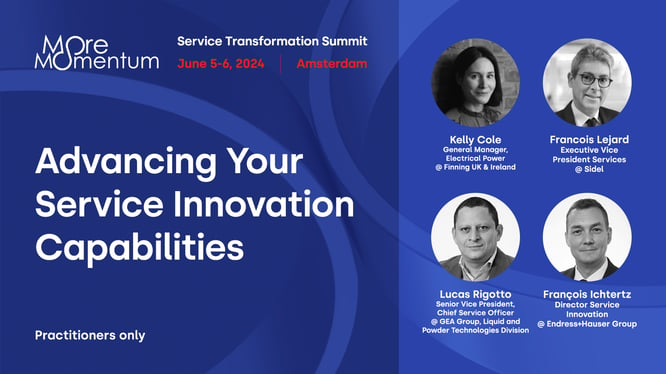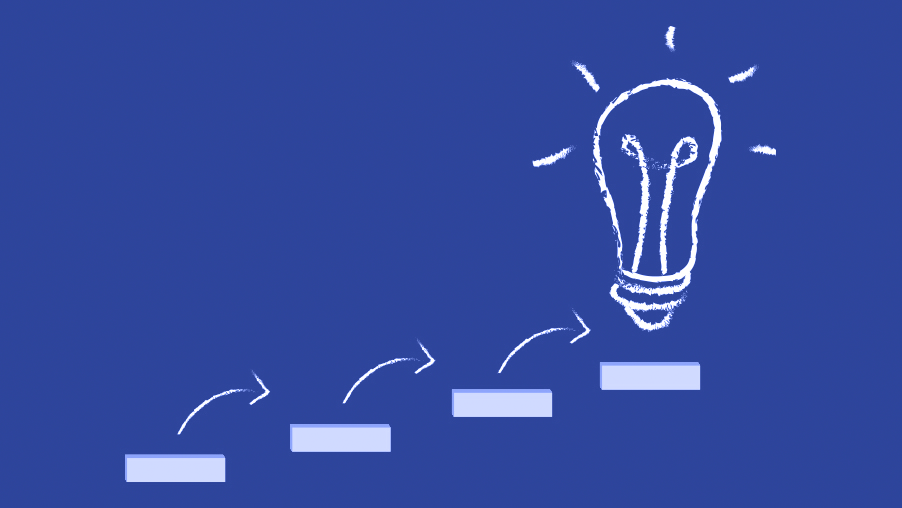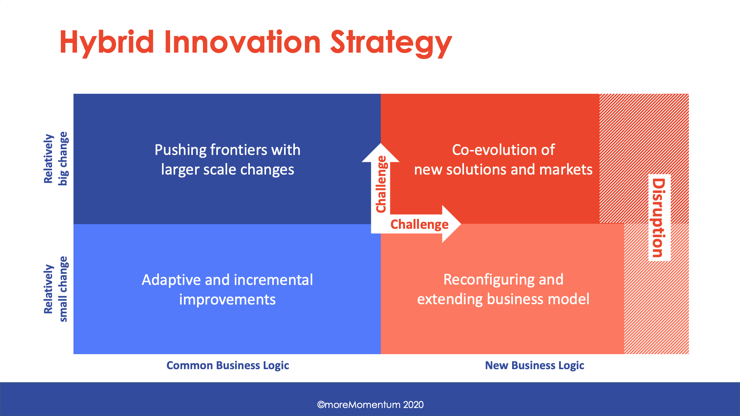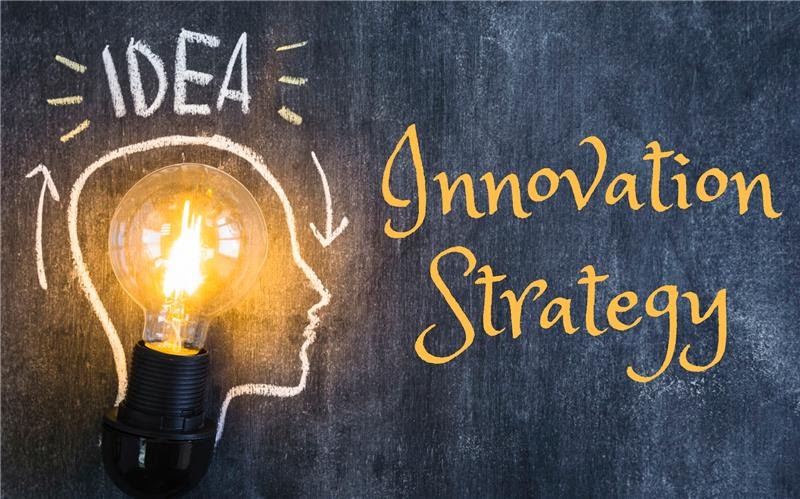Navigating innovation in B2B manufacturing is essential for transforming services into strategic business lines. Adopting tailored methodologies for each innovation phase and maintaining a fast pace will give you a competitive edge and drive sustainable service growth.
Introduction
Innovation has become a cornerstone for success in today's competitive landscape, especially in the service sector. For B2B manufacturers, the stakes are even higher. As services evolve from being mere operational functions to strategic business lines, the need for innovation becomes not just beneficial but essential.
However, innovation is not a one-size-fits-all endeavour. The many alternative methodologies available can be both a benefit and a challenge, making the selection of the right approach crucial for achieving desired outcomes.
This article will help you to navigate the complex terrain of innovation methodologies, emphasizing the importance of tailoring your approach based on the different phases of innovation.
We will delve into various innovation methodologies—from idea generation techniques like Design Thinking and Empathic Design to development approaches like Lean Start-Up. We will also explore how to successfully introduce new products or services and scale them up using Agile Development. By the end, you'll understand how to strategically employ these methodologies to drive growth and maintain a competitive edge.
Service Innovation and Business Innovation
In advanced services, a narrow focus simply won't suffice. These services often necessitate a broader perspective extending beyond the service to encompass various business aspects.
Revenue models, commercial channels, customer segmentation, organizational capabilities, strategic partnerships, and even intellectual assets come into play. For instance, a new service offering may require not just a unique value proposition but also a rethinking of existing revenue streams, creating new distribution channels, or establishing partnerships to reach new customer segments.
This multifaceted complexity often culminates in the need for business model innovation within the service business. It's not just about innovating the service offering; it's about reimagining how the company creates, delivers, and captures value. This could mean altering pricing strategies, adopting new technologies, or entering unconventional partnerships to enhance the service offering.
As services become more advanced, they often evolve into integrated solutions that combine products, software, and ongoing support. This evolution has a ripple effect on the overall business model. What was once a straightforward product or service offering becomes a complex, multifaceted solution that necessitates a holistic approach to innovation—one that considers not just the service but the entire business ecosystem.
The Need for Methodical Innovation
Innovating in the service sector comes with its unique set of challenges. Common pitfalls that lead to limited success and unnecessary risks include:
- Failing to address a problem that customers recognize.
- Falling into the commodity trap by only developing services similar to competitors.
- Not considering all essential facets of the service business to drive it's success.
- Investing heavily before validating their innovations' desirability, viability, and feasibility.
- Launching without preparing the organization to sell and deliver.
- Failing to manage the scaling beyond early adopters.
Regarding business model innovation, the complexity and interdependencies add another layer of difficulty.
Given these challenges, a structured approach to innovation becomes indispensable. Methodical innovation helps navigate these complexities, mitigate risks, and ensure that the organization is aligned for successful implementation and scaling.
Read more about Service Innovation in our
Ultimate Guide for Service Innovation
Phases of Innovation
In the innovation journey, it's crucial to recognize its different phases, each requiring a distinct approach.
The phases typically include:
- Idea Generation: Where creative thinking reigns.
- Developing Viable Solutions: Focused on achieving product-solution fit and product-market fit.
- New Product/Service Introduction: The crucial launch phase.
- Scaling Up: Expanding the innovation beyond early adopters.
Understanding these phases allows for strategically applying various methodologies, enhancing the likelihood of success.
Methods for Idea Generation
The first phase of innovation is Idea Generation, a critical stage where suitable methodologies can make a significant difference.
Design Thinking
- Problem it Solves: The number one challenge that Design Thinking addresses is the lack of user-centricity in traditional innovation approaches.
- What it Is and Benefits: Design Thinking is a human-centred methodology focusing on empathy, ideation, and experimentation to solve complex problems. Its benefits include fostering creativity, reducing risks, and achieving better user alignment.
- Scenarios Where it Shines: This approach is particularly effective when solving complex problems that are ill-defined or unknown.
Empathic Design
- Problem it Solves: Empathic Design primarily solves the issue of the disconnect between what businesses think customers want and what customers need.
- What it Is and Benefits: Empathic Design is an observational approach that seeks to understand user needs on a deep, emotional level. Benefits include higher customer satisfaction and loyalty and the potential for disruptive innovation.
- Scenarios Where it Shines: Empathic Design is particularly useful for revealing the intangible or emotional aspects of a problem, making it highly effective for services or products where emotional engagement is critical.
Jobs-to-be-Done (JTBD)
- Problem it Solves: JTBD addresses the issue of developing solutions that may be technically sound but don't resonate with what customers are trying to achieve. It bridges the gap between product features and customer goals.
- What it Is and Benefits: The methodology shifts the focus from product features to customer goals. Benefits include identifying unmet needs and developing solutions directly aligned with customer needs.
- Scenarios Where it Shines: JTBD is especially effective in situations where:
- Clear Customer Jobs Exist: In industries where customers hire products or services to solve specific problems.
- High-Stakes Decisions: In sectors where the cost of failure is high.
- Complex Customer Needs: In markets where customer needs are multifaceted and not easily understood through traditional research methods.
Methods for Developing Viable Solutions
Lean Start-Up
The journey of innovation often hinges on the ability to develop viable solutions. A key methodology that has proven effective in this phase is the Lean Start-Up approach, specifically the Minimum Viable Product (MVP) concept.
Lean Start-Up with a Minimum Viable Product (MVP):
- Problem it Solves: The Lean Start-Up methodology primarily tackles the challenge of uncertainty when exploring new customer problems, novel types of solutions, or advanced service models. It minimizes the risk by enabling organizations to test their hypotheses in a real-world setting without committing extensive resources.
- Concept and Importance: At the heart of the Lean Start-Up approach is the MVP—a simplified version of the product designed to meet the needs of early adopters. The MVP serves as an iterative testbed for gathering invaluable feedback, allowing companies to validate their innovation's desirability, viability, and feasibility. This iterative process is crucial for achieving both product-solution fit and product-market fit.
- Scenarios Where it is Most Effective: The Lean Start-Up methodology shines when organizations venture into uncharted territories—solving new customer problems, creating innovative solutions, or developing advanced service models. It is particularly valuable for businesses aiming to disrupt traditional markets or create entirely new ones.
By leveraging the Lean Start-Up methodology and the concept of an MVP, organizations can navigate the complexities and uncertainties of innovation more effectively. This approach allows for agile adjustments based on real-world feedback, ensuring that the developed solutions are viable and precisely aligned with emerging market needs.
Design Sprints
- Problem it Solves: Design Sprints addresses the challenge of investing too much time and resources into a concept before validating its potential for success. The methodology allows teams to quickly identify flaws or areas for improvement, thereby reducing the risk associated with new product, service, or feature launches.
- Concept and Importance: Design Sprints are a time-constrained, five-phase process that leverages design thinking principles. The phases typically include Understand, Sketch, Decide, Prototype, and Validate. Within a short timeframe, often just five days, teams go from problem identification to a tested prototype. This rapid cycle enables organizations to validate or invalidate assumptions quickly, saving time and resources.
- Scenarios Where it is Most Effective: Design Sprints are particularly useful for projects that require rapid validation and iteration. They are ideal for interdisciplinary teams working on complex problems where quick decision-making is essential. This methodology is often employed in the tech industry but is increasingly being adopted in healthcare, finance, and other sectors aiming for rapid innovation.
By utilizing Design Sprints, organizations can accelerate innovation and arrive at viable solutions more efficiently. This methodology allows for quick pivots based on real-world testing, ensuring that the final product or service is better aligned with user needs and market demands.
Combining the two
Design Sprints can be the initial phase for rapid problem identification and solution prototyping, followed by the Lean Start-Up methodology to develop a Minimum Viable Product (MVP) based on the validated prototype.
This combination allows for quick, low-risk validation of ideas through Design Sprints and a more in-depth, iterative process to refine the service solution using Lean Start-Up principles.
By integrating the two methodologies, organizations can achieve a more efficient and effective innovation process, reducing both the time and resources required to bring a viable product to market.
Methods for New Product/Service Introduction
Introducing a new service in today's competitive market requires more than just a well-developed offering; it demands a comprehensive approach to ensure commercial success.
Effective preparation for service delivery and a well-aligned marketing strategy are often overlooked but are essential components in this equation. These elements are vital differentiators for a successful launch and ongoing service management.
Typical challenges are:
- Alignment with Strategy: Ensuring the new service aligns with the overall business and service strategy.
- Operational Complexity: Managing various operational elements, from staff training to resource allocation and marketing, for a successful launch.
- Market Reception: The risk that the market may not receive the new service as positively as expected, affecting ROI.
New Service Introduction involves many facets, such as:
- Market Readiness: Finalizing the marketing strategy, including pricing, promotion, and distribution channels. This also involves identifying target customer segments and tailoring service packages.
- Service Design: Designing the service to be scalable, repeatable, and standardized to ensure consistent quality and customer experience.
- Quality Assurance: To ensure the service meets all standards and specifications, implementing quality checks and controls, often through pilot testing or soft launches.
- Resource Allocation: Ensuring that all human and technical resources, such as staff and IT infrastructure, are in place and operational.
- Service Delivery Preparation:
- Training: Educating staff involved in service delivery on the specific procedures, tools, and customer interactions required for the new service.
- Management Systems: Implementing or updating service management systems to handle scheduling, tracking, and reporting related to the new service.
- Launch Planning: Coordinating the official market launch, which may include promotional events, webinars, or targeted marketing campaigns.
- Marketing Alignment: Developing and executing marketing campaigns aligned with the sales strategy, including digital marketing, content creation, and customer testimonials to drive awareness and demand.
- Sales Enablement
- Sales Training: Training equips the sales team with essential knowledge about the service's features and benefits. Role-playing and product demos are common methods used for effective training.
- Targets and Incentives: Clear sales targets and incentives drive focus and motivation. Targets should be challenging yet achievable, and incentives can include financial bonuses or career growth.
- Sales Content and Materials: Sales teams are provided with materials like brochures and presentations to articulate the service's value. These resources are tailored to meet customer needs and questions.
- Expert Support / Sales Support: Expert support enhances the sales team's confidence. This can include on-call technical assistance or insights to help overcome customer objections.
- Monitoring and Feedback: Collecting data on service performance, customer feedback, and market reception for ongoing analysis and adjustments.
Methods for Scaling Up
Agile Development for Services
- Problem it Solves: The primary challenge Agile Development solves is the inability of traditional models to adapt quickly to changing market conditions, and customer needs in the service sector.
- Concept and Importance: Agile Development is an iterative approach that prioritizes collaboration, customer feedback, and adaptive planning. It is applied to service product management to facilitate continuous improvement and adaptation.
- Benefits:
- Adaptability: Enables services to evolve in response to market changes and customer feedback.
- Customer-Centric: Allows for the continuous integration of customer insights into service improvements.
- Resource Efficiency: Facilitates prioritization of tasks, ensuring that resources are allocated where they have the most impact.
- Scenarios Where it is Most Effective:
- Complex Service Offerings: Where customer needs and market conditions are variable.
- Rapidly Changing Markets: Where services must adapt quickly to maintain a competitive edge.
- Cross-Functional Teams: Especially important when collaboration is required across various departments like service design, marketing, and customer support.
By adopting Agile Development in the scaling-up phase, organizations can ensure that their services are continuously refined and adapted to meet evolving market needs and customer expectations.
Managing growth
Managing the growth of a service business or just a particular service can be a significant challenge. It involves elements like:
- Capacity Planning: Ensuring that the organization has the human and material resources to handle increased demand.
- Quality Assurance: Maintaining the quality of the service as it scales to ensure customer satisfaction and retention.
- Operational Efficiency: Streamlining operations to handle increased volume without compromising service quality or incurring excessive costs.
- Market Expansion: Identifying and entering new markets or customer segments without diluting the core value proposition.
- Customer Experience: Managing the customer journey at every touchpoint, especially as the service grows and becomes more complex.
- Financial Management: Ensuring profitability while scaling, including budgeting and revenue forecasting.
- Team Collaboration and Communication: Effective communication becomes crucial for coordinated action as teams grow and become more specialized.
- Strategic Alignment: Ensuring that the scaling efforts align with the organization's overall strategy and long-term goals to maintain focus and direction.
Conclusion
In today's fast-paced B2B manufacturing sector, innovation isn't a luxury—it's a necessity. As services transition from operational functions to strategic business lines, the complexity of innovation methodologies can be both a challenge and an opportunity. The key lies in selecting the right approach for each phase of innovation, from idea generation to scaling up.
But remember, the pace of innovation is crucial. The quicker you adapt these methodologies and insights into your service transformation journey, the more competitive your edge will be.
So, service leaders and innovation teams, the next steps are yours to take. Utilize the knowledge and strategies outlined in this article to accelerate your innovation efforts. Turn these insights into actionable plans and keep your innovation engine running at full throttle.
It's time to set a winning pace in your service transformation journey.

The Service Transformation Summit on Advancing Your Service Innovation Capabilities covered the content of this article and more, such as:
- Innovation Methodologies
- New Service Introduction
- Agile Service Product Management
This Summit, which took place on June 5-6, 2024, was a unique opportunity to deepen your understanding of these topics, connect with industry leaders, and engage in enriching discussions about real-world cases of your like-minded peers.
So, if you're passionate about service transformation and are committed to sparking positive change in your organization, we warmly invite you and your service leadership teams to join us at our upcoming Summits.
Let's transform the service industry together.
Jan van Veen
Sep 21, 2023 1:27:46 PM




